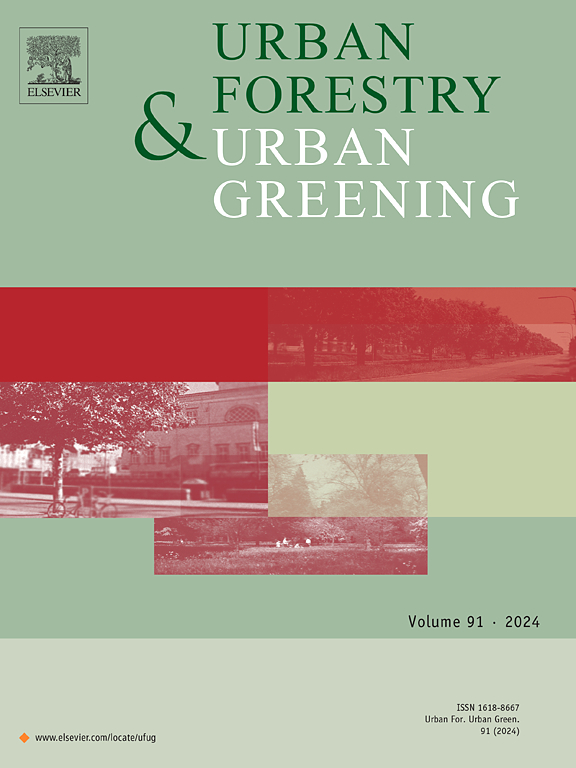A study on the risk evaluation of tilted street trees
IF 6
2区 环境科学与生态学
Q1 ENVIRONMENTAL STUDIES
引用次数: 0
Abstract
Urban tilted street trees (TSTs) pose chronic risks to pedestrians and vehicles due to their tilted trunks. These often-unnoticed risks necessitate systematic assessment for proactive accident prevention. However, existing frameworks globally fail to systematically evaluate stable tilted trees, and the urgency of chronic spatial encroachment risks remains understudied. Adopting a micro-environmental perspective, this study developed a risk assessment model using data from 15 streets in Shibei District, Qingdao, integrating the Analytic Hierarchy Process-Entropy Weight Method (AHP-EWM) with fuzzy evaluation. Incorporating three dimensions and eight indicators, the model generated spatial risk distribution maps of risk degree of tilted trees (RDT) for existing TSTs in the study area. The analysis identified 5.3 % of trees as high-risk (RDT ≥ 0.67) and 36.4 % as moderate-risk, with aggregation patterns showing species-specific (e.g., Populus dominance) and geographic clustering. Univariate analysis revealed significant positive correlations between RDT and tree tilt angle (αt; r = 0.988, P < 0.001) and lowest branch influence width (Lw; r = 0.719, P < 0.001), suggesting that larger tilt angles and reduced clearance from low-hanging branches amplify risk levels. In contrast, diameter at breast height (DBH) showed no significant correlation with other parameters. This study offers a risk-level framework for urban forestry authorities to prioritize maintenance based on risk severity, and to identify locally prevalent high-risk tree species. The framework facilitates the development of digital risk archives to support whole-life-cycle tree management through public engagement initiatives. Furthermore, it recommends disseminating high-risk tree data via IoT-enabled platforms to enhance collision prevention. The parametric design of the framework allows for dynamic risk evaluation adaptable to various urban environments.
倾斜行道树风险评价研究
城市倾斜行道树由于其倾斜的树干对行人和车辆构成慢性风险。这些经常被忽视的风险需要系统评估,以主动预防事故。然而,全球现有框架未能系统地评估稳定倾斜树木,慢性空间侵蚀风险的紧迫性仍未得到充分研究。以青岛市市北区15个街道为研究对象,采用微观环境视角,将层次分析法-熵权法(AHP-EWM)与模糊评价相结合,建立了风险评价模型。该模型包含3个维度和8个指标,生成了研究区现有sts倾斜树风险度的空间风险分布图。分析结果显示,5.3%的树木为高风险(RDT≥0.67),36.4%的树木为中等风险,聚集模式显示物种特异性(如杨树优势)和地理聚类。单因素分析显示,RDT与树木倾斜角(αt;r = 0.988, P <;0.001)和最低支路影响宽度(Lw;r = 0.719, P <;0.001),这表明较大的倾斜角度和低悬树枝的间隙减少会增加风险水平。胸径(DBH)与其他参数的相关性不显著。该研究为城市林业管理部门提供了一个风险等级框架,以确定基于风险严重程度的优先维护,并确定当地普遍存在的高风险树种。该框架促进了数字风险档案的发展,通过公众参与倡议支持全生命周期树管理。此外,它建议通过支持物联网的平台传播高风险树木数据,以加强碰撞预防。框架的参数化设计允许适应各种城市环境的动态风险评估。
本文章由计算机程序翻译,如有差异,请以英文原文为准。
求助全文
约1分钟内获得全文
求助全文
来源期刊

Urban Forestry & Urban Greening
FORESTRY-
CiteScore
11.70
自引率
12.50%
发文量
289
审稿时长
70 days
期刊介绍:
Urban Forestry and Urban Greening is a refereed, international journal aimed at presenting high-quality research with urban and peri-urban woody and non-woody vegetation and its use, planning, design, establishment and management as its main topics. Urban Forestry and Urban Greening concentrates on all tree-dominated (as joint together in the urban forest) as well as other green resources in and around urban areas, such as woodlands, public and private urban parks and gardens, urban nature areas, street tree and square plantations, botanical gardens and cemeteries.
The journal welcomes basic and applied research papers, as well as review papers and short communications. Contributions should focus on one or more of the following aspects:
-Form and functions of urban forests and other vegetation, including aspects of urban ecology.
-Policy-making, planning and design related to urban forests and other vegetation.
-Selection and establishment of tree resources and other vegetation for urban environments.
-Management of urban forests and other vegetation.
Original contributions of a high academic standard are invited from a wide range of disciplines and fields, including forestry, biology, horticulture, arboriculture, landscape ecology, pathology, soil science, hydrology, landscape architecture, landscape planning, urban planning and design, economics, sociology, environmental psychology, public health, and education.
 求助内容:
求助内容: 应助结果提醒方式:
应助结果提醒方式:


